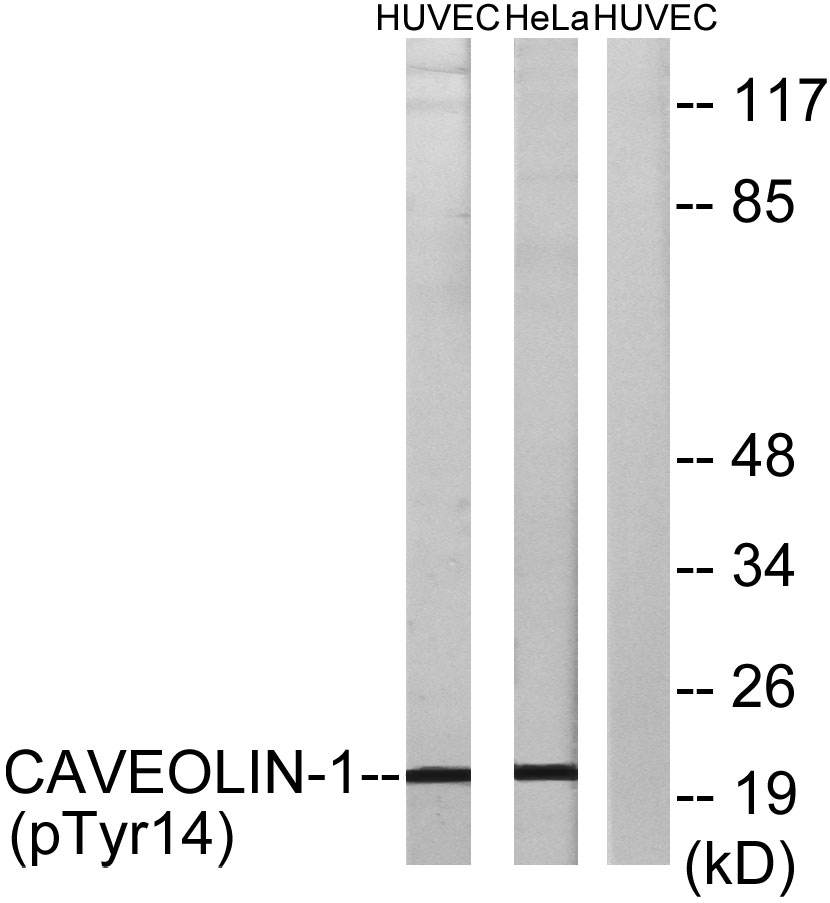Caveolin-1 (phospho Tyr14) Polyclonal Antibody
- Catalog No.:YP0050
- Applications:WB;ELISA
- Reactivity:Human;Mouse;Rat
- Target:
- Caveolin-1
- Fields:
- >>Endocytosis;>>Focal adhesion;>>Prion disease;>>Bacterial invasion of epithelial cells;>>Proteoglycans in cancer;>>Viral myocarditis;>>Fluid shear stress and atherosclerosis
- Gene Name:
- CAV1
- Protein Name:
- Caveolin-1
- Human Gene Id:
- 857
- Human Swiss Prot No:
- Q03135
- Mouse Gene Id:
- 12389
- Mouse Swiss Prot No:
- P49817
- Rat Swiss Prot No:
- P41350
- Immunogen:
- The antiserum was produced against synthesized peptide derived from human Caveolin-1 around the phosphorylation site of Tyr14. AA range:5-54
- Specificity:
- Phospho-Caveolin-1 (Y14) Polyclonal Antibody detects endogenous levels of Caveolin-1 protein only when phosphorylated at Y14.
- Formulation:
- Liquid in PBS containing 50% glycerol, 0.5% BSA and 0.02% sodium azide.
- Source:
- Polyclonal, Rabbit,IgG
- Dilution:
- WB 1:500 - 1:2000. ELISA: 1:20000. Not yet tested in other applications.
- Purification:
- The antibody was affinity-purified from rabbit antiserum by affinity-chromatography using epitope-specific immunogen.
- Concentration:
- 1 mg/ml
- Storage Stability:
- -15°C to -25°C/1 year(Do not lower than -25°C)
- Other Name:
- CAV1;CAV;Caveolin-1
- Observed Band(KD):
- 20kD
- Background:
- The scaffolding protein encoded by this gene is the main component of the caveolae plasma membranes found in most cell types. The protein links integrin subunits to the tyrosine kinase FYN, an initiating step in coupling integrins to the Ras-ERK pathway and promoting cell cycle progression. The gene is a tumor suppressor gene candidate and a negative regulator of the Ras-p42/44 mitogen-activated kinase cascade. Caveolin 1 and caveolin 2 are located next to each other on chromosome 7 and express colocalizing proteins that form a stable hetero-oligomeric complex. Mutations in this gene have been associated with Berardinelli-Seip congenital lipodystrophy. Alternatively spliced transcripts encode alpha and beta isoforms of caveolin 1.[provided by RefSeq, Mar 2010],
- Function:
- disease:Defects in CAV1 are the cause of congenital generalized lipodystrophy type 3 (CGL3) [MIM:612526]; also called Berardinelli-Seip congenital lipodystrophy type 3 (BSCL3). Congenital generalized lipodystrophies are autosomal recessive disorders characterized by a near absence of adipose tissue, extreme insulin resistance, hypertriglyceridemia, hepatic steatosis and early onset of diabetes.,function:May act as a scaffolding protein within caveolar membranes. Interacts directly with G-protein alpha subunits and can functionally regulate their activity.,online information:Caveolin entry,PTM:The initiator methionine for isoform Beta is removed during or just after translation. The new N-terminal amino acid is then N-acetylated.,similarity:Belongs to the caveolin family.,subcellular location:Potential hairpin-like structure in the membrane. Membrane protein of caveolae.,subunit:Homooligo
- Subcellular Location:
- Golgi apparatus membrane; Peripheral membrane protein. Cell membrane; Peripheral membrane protein. Membrane, caveola ; Peripheral membrane protein. Membrane raft . Golgi apparatus, trans-Golgi network . Colocalized with DPP4 in membrane rafts. Potential hairpin-like structure in the membrane. Membrane protein of caveolae.
- Expression:
- Skeletal muscle, liver, stomach, lung, kidney and heart (at protein level). Expressed in the brain.
- June 19-2018
- WESTERN IMMUNOBLOTTING PROTOCOL
- June 19-2018
- IMMUNOHISTOCHEMISTRY-PARAFFIN PROTOCOL
- June 19-2018
- IMMUNOFLUORESCENCE PROTOCOL
- September 08-2020
- FLOW-CYTOMEYRT-PROTOCOL
- May 20-2022
- Cell-Based ELISA│解您多样本WB检测之困扰
- July 13-2018
- CELL-BASED-ELISA-PROTOCOL-FOR-ACETYL-PROTEIN
- July 13-2018
- CELL-BASED-ELISA-PROTOCOL-FOR-PHOSPHO-PROTEIN
- July 13-2018
- Antibody-FAQs
- Products Images
.jpg)
- Western Blot analysis of HeLa cells using Phospho-Caveolin-1 (Y14) Polyclonal Antibody diluted at 1:1000

- Western blot analysis of lysates from HUVEC cells treated with PMA 125ng/ml 30' and HeLa cells treated with LPS 100ng/ml 30', using Caveolin-1 (Phospho-Tyr14) Antibody. The lane on the right is blocked with the phospho peptide.



